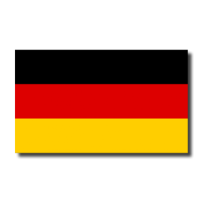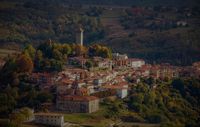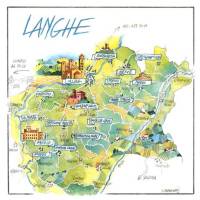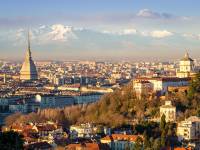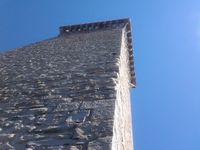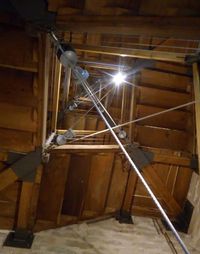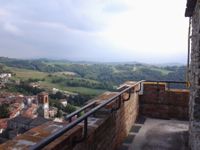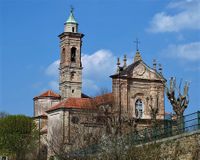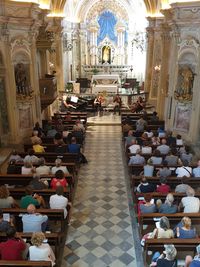Location
Casa Rea is located on the edge of the village of Murazzano, right below the cemetery. Murazzano is located in the south of Piedmont, in the border area with Liguria. The distance from London to Murazzano is approximately 1325 km, travel time approximately 15.5 hours. |
Holiday home Casa Rea Frazione Rea 5a E-mail: info@casarea.eu
Electric car charging points Charging points have been installed for two cars in our village of Murazzano. Check the Nextcharge map for the nearest public charging point for your electric car outside Murazzano. There are also a range of useful apps: Chargemap, Shell recharge, EV Charging, ABRP (A better route planner). |
Murazzano
Our picturesque village of Murazzano is within walking distance of Casa Rea and has approximately 800 inhabitants. The village has various facilities such as bars, shops and restaurants. There are seven churches in Murazzano, of which the Church of Saint Laurentius is the oldest (1409). There are a few frescoes and paintings in this church. Since Murazzano sits on top of a hill, there are beautiful views of the region on all sides. Until the end of the eighteenth century, next to the tower of Murazzano there was a castle, built in the fourteenth century by the Marquis of Saluzzo. The town is linked to the royal family, because many doctors at the court came from Murazzano. Murazzano is part of the "Strada Romantica", a beautiful route through the Langhe. Murazzano is visited by many motorcyclists, cyclists and walkers as part of a tour.
To do in Murazzano
|
|
Holiday in Piemont
For many people who want to go on holiday to Italy, Piedmont is still an unknown destination. Anyone who has been on holiday in Piedmont and the Langhe has experienced that Piedmont is the new Tuscany of Italy. A large part of our region has rightly been added to the UNESCO world heritage list.
The Piedmont region is located in the northwest of Italy, close to the Alps. The literal translation of Piedmont is 'at the foot of the mountains'. However, this large region has much more to offer than just the Alps. Lake Maggiore and the smaller Lago di Orta in the north, the capital Turin and a very varied landscape with beautiful nature reserves where you can enjoy walking, cycling and skiing or just enjoy the beautiful nature. From a landscape perspective, Piedmont can easily compare with popular Tuscany.
Piedmont can further be characterized as the Burgundy of Italy. The Piedmontese love delicious food, accompanied by a good glass of wine. The region produces the most beautiful wines in Italy, such as the famous Barolo and Barbaresco, but also the Asti Spumante or Moscato d'Asti. Around Acqui Terme, one of Italy's oldest thermal spa resorts, lies the Dolcetto & Brachetto wine region, which is also |
home to Italy's most famous Grappa distiller. It is therefore no coincidence that the global Slow Food movement originated in this region (Bra). Slow Food is an independent organization that is committed to enjoying pure and honest food, rooted in gastronomic tradition.
The Langhe
You can enjoy yourself for a few weeks in the wine villages of the Langhe, in and around Alba. In autumn, the international truffle market is held in Alba. For a whole month everything is dedicated to this with many festivals and on the first Sunday of October there is the Palio degli Asini, a donkey race through the city. A traditional palio with horses is held in Asti. In the beautiful nature of this region with many castles and abbeys you can enjoy cycling and walking between the rolling hills.
The region, the Langhe, is famous for its wide variety of delicious mushrooms. Enthusiasts from all over the world come to this region to enjoy the gastronomic delights of this region, in particular the white truffle and wine.
Turin
Turin is the capital of Piedmont, the city where Fiat is headquartered. However, Turin is not a gray industrial city, but an elegant and charming city with a baroque center and beautiful shopping arcades where you can shop all day long.
Cuneo
The city of Cuneo is also the capital of the Province of Cuneo. Every year the regional cheese market is held here at the beginning of November. Countless varieties are then displayed there. Cuneo also hosts the largest market in the region every Tuesday. In preparation for your trip, we can recommend the 'Piemonte, wine and travel atlas'. This contains specially designed maps and texts about wine, culture and history. Atlas format and in English.
Events in Piemonte
Various festivities are organized in the various villages in the area, especially from July to September, which make a holiday in Piedmont even more fun. During a stay at Casa Rea we will inform you about what festivities there are during that period. In Murazzano itself, the month of August in particular is dedicated to various festivities, with something to do almost every day, including for the children. We have been organizing a music series for a few years now Pomeriggi in Musica, where you can attend a concert on 6 Sundays in July and August at various locations in Murazzano.
More about Murazzano
History
Murazzano is first mentioned in ancient Roman documents; called Mulatianum in Latin and Mulassano in the vernacular. It describes the foundation ("Fundus Munatianum") of Murazzano by the Romans around 173 BC, when they succeeded in subduing the Ligurians. In the tenth century, the entire Langhe region was ravaged by Saracen raids, causing an exodus from the region. In 1143, Murazzano is mentioned in a deed, where it is part of the Marca Aleramica. In 1210, Murazzano came into the possession of the Marquis of Saluzzo until 1463 when it was bought by the Savoys, for its strategic position. Due to various circumstances, the Savoy did not actually come into Murazzano's possession until 1625. During the Napoleonic period (around 1800), the castle of Murazzano was destroyed.
The symbol of Murazzano
The Tower with its base of 33 meters is the symbol of Murazzano. It is built on the hill in the center of the village. The Tower has no foundation but is built directly on the local type of stone, called tufo. The sturdiness is guaranteed by the 1.5 meter thick walls.
History tells us that when there was a major earthquake in the Imperia region, the tower swayed dangerously. Luigi Drochi said, “His sides bent like a tree,” but he did not fall, symbolizing “we still have something heavenly.”
It is thought that the Tower was built at the same time as the castle. In a deed from 1222, the tower is called 'the man' and was connected to the castle by a drawbridge. The bridge allowed the inhabitants to retreat to the Tower as a last resort when under siege. For this reason, the main entrance is 7 meters above the ground. Entering the Tower, before you go up the stairs, there is a room under the floor, which was probably used as a prison. On the south side of the Tower you can still see the remains of the foundations of the two round towers of the castle.
For centuries, the Tower was of great strategic importance due to its position dominating the road from Piedmont to the sea. In a document from 1463 the tower is mentioned as “The Shield and Key of Piedmont”. In 1820, during the Napoleonic period, the castle was destroyed by fire. Later, the Tower and the area around it came into the possession of the Manfredi family and the Alliani family, who eventually donated it to Murazzano in 1924. The monument was already showing signs of age and this was exacerbated by a lightning strike. Various restorations were necessary. All credit for the preservation of the tower goes to Carlo Visetti, who belonged to an ancient and noble family from Murazzano. In 1927 and 1928, Mr. Visetti carried out the restoration of the Tower and supervised it expertly. It became possible to climb the Tower again. During the Second
World War, 4 soldiers were stationed on the Tower to locate Allied bombers on their way to Turin. Restoration work was again carried out in 2003. The walls have been cleaned and repointed, cracks have been repaired and a new internal staircase has been installed. Now the Tower, in all its glory, offers those who wish the opportunity to climb to the top in comfort and to enjoy exceptional views over the Langhe, the Po Valley and the Alps on clear days.
Santuario Beata Vergine di Hal ( Madonna d'Hal )
The Shrine of Our Lady of Halle in Murazzano was built on the remains of an older church sometime in the first half of the 1600s; "S. Maria di Buzzignano extra muros" built. In the second half of 1600, the Philippine Fathers arrived and built one of their monasteries next to the Santuario, giving the church its current appearance. In a few decades they built a central nave, four side chapels, the transept, the presbytery on which stands a majestic dome and the artistic altar on which the statue of the Madonna is placed. The first service was on Easter Sunday in 1620. The entire building is built in plain stone. The interior is completely painted with unprecedentedly beautiful floral motifs and trompe l'oeuil, making it one of the most beautiful sanctuaries in the region.
Since 1630, the Shrine of Our Lady of Halle in Murazzano has venerated an image of Mary and child, painted on a slate. They are shown under a richly decorated dress. The Virgin Mary's dress shows the coat of arms of Spinola, a noble Genoese family. Below the painting is a Latin inscription testifying that the statue was given to the Duchess Maria Spinola. We do not know how the painting got to Murazzano and who painted it. All documents relating to the church were kept in the sacristy, which was burned by Napoleon's troops in 1799. However, it is known that Ambrogio Spinola, Maria's brother, was governor of Flanders on behalf of Spain until 1628. The painting was inspired by a wooden statue venerated in Halle in Belgium, given by St. Elizabeth of Hungary to her daughter Sofia when she married the Duke of Brabant. Sofia's granddaughter Alice then donated the statue in question to the city of Halle in 1266. The statue was covered with lavish clothes and that is how the unknown painter of the painting saw it when he made it on behalf of Ambrogio Spinola. The presence of the statue of Our Lady of Halle has always been considered a sign of goodwill on the part of Heaven. The faithful took refuge in her, to thank her and to admire her beautiful face, which gave them courage and hope. At the end of the Second World War (1944), the Germans wanted to raze Murazzano to the ground by setting it on fire. Murazzano's patronage was attributed to the Madonna.
Pomeriggi in Musica
During the summer months, Murazzano is home to a large group of permanent and temporary residents. It became clear to us that there had to be enough musical talent within this group of people. This is how we came up with the idea of organizing a music series in the summer months from July to September, making use of these talents. The goal was to provide an enjoyable musical experience for anyone who loves music and to provide a stage on which these talents can perform. In a relaxed atmosphere and without pretensions, the first series of concerts started in the summer of 2017. With the help of the municipality of Murazzano, the concerts were organized at two great locations in Murazzano. A small church (Chiesa dei Battuti Neri) on the village square and a large church at the old entrance to the village (il Santuario Madonna di Hal).
After successfully completing the first edition of Pomeriggi in Musica in 2017, we decided together with the municipality to make this festival an annual tradition.

